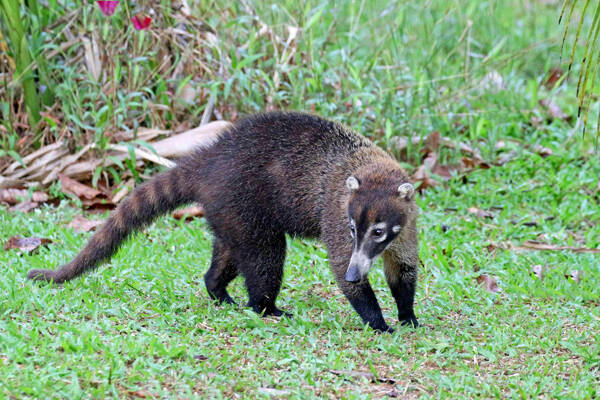Nasua narica
IUCN
LCBasic Information
Scientific classification
- name:Nasua narica
- Scientific Name:Nasua narica,White-nosed coati,White-nosed pig
- Outline:Carnivora
- Family:Procyonidae Procyoninae Raccoon
Vital signs
- length:80-130cm
- Weight:3-5kg
- lifetime:About 12 years
Feature
The biggest difference from the common coati is that there is a white stripe in the middle of the nose.
Distribution and Habitat
Origin: Belize, Colombia, Costa Rica, El Salvador, Guatemala, Honduras, Mexico, Nicaragua, Panama, United States.
The distribution range of white-nosed coatis extends southward from Arizona and New Mexico in the United States, through Mexico (excluding the Baja Peninsula and the central Sierra Madre), Central America to Panama, and a small amount is distributed west of the Andes Mountains in South America.
White-nosed coatis live at an altitude of 0 to 3,500 meters. White-nosed coatis are adapted to various geographical environments in the Americas, from tropical lowlands to dry, high-altitude forests such as rainforests and cloud forests.
Appearance
The body is gray-brown, with silver-gray arms. The nose is long and pointed with a flexible tip. There is a white band on the facial area near the end of the nose. There is a white spot on both eyes and the upper and lower cheeks on both sides, and the throat and abdomen are stained with white.
The front legs are shorter than the hind legs and can walk on the soles. The feet are black and bare. The claws of the front limbs can be bent. The long cone-shaped tail has black rings and the tail remains upright when walking.
The body length of an adult white-nosed coati is 80~130 cm, of which the tail length accounts for more than half of the body length; the weight is 3~5 kg.
Differences between similar species: The markings on the snout are the only feature that distinguishes the white-nosed coati from its close relatives, the southern coati and the long-nosed coati.
Details
White-nosed coati (scientific name: Nasua narica) has four subspecies.

White-nosed coatis are diurnal, usually roosting in treetops at night and descending from trees to forage at dawn; adult males occasionally move at night. When looking for food, they first use their flexible long noses to sniff, then bend their claws to dig underground insects, larvae and small vertebrates. Adult males generally live alone, marking their territories by spraying urine or rubbing their abdomens on the ground to release secretions. The territories of males do not overlap, and if two males meet in the same territory, they will fight each other. Females and young animals live in groups, and the size of the group is generally 4 to 20, consisting of females and males under the age of 2. Group members are not necessarily related. Females in the group take care of and groom the young animals; they do not cooperate in hunting or sharing food, but work together to resist adult males and other intruders. Females raise their offspring alone in tree nests. The mortality rate of young animals may be high when they leave the nest for the first time, and the threats mainly come from other adult raccoons, large cats, monkeys, pythons and diseases.
From February to March each year, males who dominate the female home range will be allowed to join the female group. Once joined, males will mate with every group member and are then driven away because they will kill the cubs. The gestation period of white-nosed coatis lasts 77 days. About 3 to 4 weeks before giving birth, females will leave the group to build a den alone, the most common den being built in a palm tree. A litter of 2 to 7 cubs will stay in the tree den for several weeks. Newborn cubs weigh 100 to 180 grams and still need the care of their mother to survive. The mother only leaves the tree den when foraging. The cubs open their eyes after 11 days, are weaned after 4 months, and after 5 months, the mother and cubs come down from the tree and rejoin the previous group. The cubs grow up after 15 months. Male coatis reach sexual maturity at 3 years old and females at 2 years old.
The global population of white-nosed coatis has not been quantified, and they are rare or common species in their native habitat. The white-nosed coati is rare in the United States; it is common to rare in Central America, but has declined significantly (Janson 1981). The population in Mexico has declined significantly and is estimated to be extinct in the central part of the country (Valenzuela &Ceballos 2000). Densities of coatis are higher in tropical areas than in the southwestern United States (Gommper 1995, 1997). The species is extremely common in Costa Rica (J. González-Maya pers. comm. 2008).
The white-nosed coati population in Honduras is listed in Appendix III of the Convention on International Trade in Endangered Species of Wild Fauna and Flora (CITES).
Listed in the IUCN Red List: Least Concern (LC), assessed in 2015.
Listed in Appendix I, II and III of the Convention on International Trade in Endangered Species of Wild Fauna and Flora (CITES) 2019 Edition Appendix III
Protect wild animals and eliminate game.
Maintaining ecological balance is everyone's responsibility!








